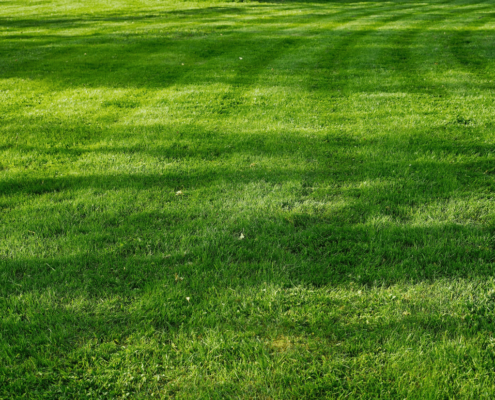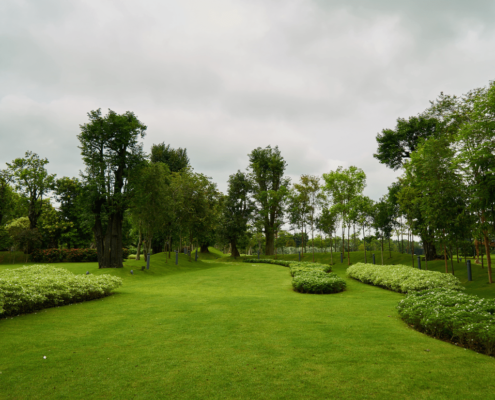10 Best Types of Grass Seed for Direct Sun, Compared
If you have a yard that is blessed with direct sunlight for most of the day, you may think that growing a lush, green lawn would be a breeze.
However, not all grass varieties can handle the intensity of full sun exposure. That’s where direct sun grass seed comes in.
What actually is a Direct Sun Grass Seed?
Direct sun grass seed is specifically designed to thrive in areas with intense sunlight.
These seed blends are composed of grass species that are known for their ability to withstand heat, drought, and other challenging conditions associated with direct sunlight.
By choosing a direct sun grass seed, you can ensure that your lawn remains healthy and vibrant even in the hottest parts of the day.
Benefits of Grass Seed For Direct Sun
The benefits of grass seed for direct sun are numerous. Firstly, these seed blends are selected for their ability to tolerate high temperatures and extended exposure to sunlight. This means that your lawn will maintain its vibrant green color and withstand the stress associated with extreme heat.
Additionally, direct sun grass seed often includes species that have deep root systems, allowing them to access water and nutrients more effectively, ensuring the overall health and longevity of your lawn.
Grass Seed Species For Direct Sun: The Best 10 Species Compared
| Grass | USDA Zones | Water Usage | Grass Aspect | Maintenance | Highest Dormant Period | Average Height |
|---|---|---|---|---|---|---|
| Bermuda Grass | 7-10 | Moderate | Fine texture | High | Winter | 1-3 inches |
| Zoysia Grass | 5-10 | Low to Medium | Dense texture | Moderate | Winter | 1-2 inches |
| Buffalo Grass | 2-7 | Low | Coarse texture | Low | Summer | 2-5 inches |
| Centipede Grass | 7-10 | Low | Medium texture | Low to Moderate | Summer | 1-2 inches |
| St. Augustine Grass | 7-12 | High | Coarse texture | Moderate to High | Winter | 2-4 inches |
| Kentucky Bluegrass | 2-7 | Moderate to High | Fine texture | Moderate to High | Winter | 2-3 inches |
| Turf-type Tall Fescue | 4-7 | Moderate to High | Coarse texture | Moderate | Summer | 2-3 inches |
| Carex | 3-9 | Low to Medium | Depends on type | Low to High | Winter or Summer | Varies |
| Creeping Red Fescue | 1-7 and 8-10 | Low to Medium | Fine texture | Moderate to High | Winter | 4-12 inches |
| Bahiagrass | 7-11 | Low | Coarse texture | Low to Moderate | Winter or Drought | 6-20 inches |
Direct Sun Grass Seed Types In Detail & Where You Can Buy Them
Bermuda Grass
Bermuda Grass is a fast-growing grass that quickly forms a lush, green lawn under the right conditions. Native to tropical and subtropical regions, it thrives in hot and sunny weather and is also drought-tolerant, making it suitable for lawns.
Once established, Bermuda Grass is hard-wearing and is well-suited for coastal gardens and areas due to its natural salt tolerance. However, it is not suitable for northern states as its leaves and roots are sensitive to cold temperatures.
Zoysia Grass
According to Lindsey Hall, a writer at Positive Bloom, Zoysia grass is the ideal choice for sunny areas. This warm-season grass can thrive in hot climates and is hardy in USDA hardiness zones 5 to 10.
Zoysia grass, an attractive and dense dark-leaved grass, was introduced to the United States in the early 1900s, as mentioned by Rhys Charles, founder and CEO of Mower On the Lawn. It is popular for lawns due to its tolerance of both heat and cold. Additionally, its low growth rate means less frequent mowing.
Finding Zoysia grass seed is relatively easy, and it is a suitable option for areas with limited water resources. To ensure your garden can handle limited watering, consider combining it with drought-tolerant plants.
If quick growth is a priority, it’s worth noting that establishing Zoysia grass from seed can take time. If you’re in a hurry, it may be preferable to invest in sod (turf) instead.
Buffalo Grass
Buffalo grass, native to the Great Plains of North America, is renowned for its resilience in sunny conditions. According to Rhys Charles, it can withstand drought and maintain its green and healthy appearance.
As a warm-season grass, Buffalo grass thrives during spring and summer. It requires minimal maintenance and can be left to grow without the need for mowing or fertilization.
UC Verde, a notable variety introduced by the University of California, is specially bred for the Californian climate and dry desert valleys like Tucson in Arizona.
Centipede Grass
According to Shawn Denny, owner of groundwork company Specialty Grading Inc., centipede grass is a warm-season grass that thrives in full sun. It requires less fertilizer and mowing compared to other grass varieties.
While centipede grass has its advantages, it can be particular about its growing conditions. It prefers sandy, acidic soil and may need additional watering during dry spells. Additionally, its slow creeping growth creates a dense lawn, but it should be noted that it is not suitable for heavily trafficked areas due to its delicate nature underfoot.
St. Augustine Grass
St. Augustine grass is highly favored in the southern half of the US, thanks to its stunning blue-green vertical blades and remarkable drought tolerance.
According to Josh Moser, General Manager of Green Giant Home & Commercial, St. Augustine grass is the preferred choice for residential and commercial lawns in warmer climates, thriving in USDA zones 7-12. It prefers warm, well-drained soils and establishes quickly. Its dense growth can transform even the smallest of lawns into perfectly manicured carpets. To plant St. Augustine grass, plugging and sodding are typically recommended since viable seeds are not commonly produced by this grass variety.
Kentucky Bluegrass
Kentucky Bluegrass is a popular choice in cooler regions due to its quick establishment from seed, durability, and drought tolerance. What sets it apart from many other warm-season grasses are its unique growth habits.
According to Peter Landschoot, professor of turfgrass science at The Pennsylvania State University, Kentucky Bluegrass and creeping red fescue produce rhizomes beneath the soil surface. These rhizomes then turn upward, forming new shoots. This characteristic is highly desirable in turfgrasses because it enables plants to send new shoots into thin or damaged areas caused by traffic, drought, or disease. In the northern U.S., Kentucky Bluegrass is considered the premier sod grass because its rhizomes allow the turf to “knit” together, providing strength and stability during the sod cutting, rolling, and lifting process.
Turf-type Tall Fescue
Turf-type tall fescue is an excellent choice for a low-maintenance, durable, and vibrant green lawn once it has been established. Compared to other cool-season varieties, it requires less upkeep.
One of the key reasons for its resilience is its robust root system, which can delve as deep as 2 to 3 feet into the soil. This enables it to access water from deep sources, making it highly tolerant to drought and heat.
Turf-type tall fescue thrives best in well-drained, sandy soils. It forms a dense, uniform turf, ensuring that it stays within the designated lawn areas and doesn’t invade flower beds or borders.
Carex
Carex is an exquisite grass-like plant that thrives in sunny conditions. It is ideally suited for small lawn areas that are primarily for visual enjoyment rather than heavy foot traffic. Although not commonly used for lawns, this hardy and drought-tolerant grass or sedge includes many species that are native to North America.
With its low-growing and evergreen nature, Carex forms a lush and tactile display of gracefully arching blades when planted in well-draining soil. While occasional mowing, usually two or three times a season, is possible, it is best left unmown. This makes it an excellent choice if you are embracing a rewilding approach for part or all of your backyard.
Creeping Red Fescue
Creeping red fescue, also referred to as strong red fescue, is a perennial lawn grass suitable for USDA planting zones 1-7 and can be used as an annual grass in transitional zones 8-10.
This species boasts a dark green color and a fine texture. It is characterized by a dense network of shallow creeping rhizomes, which contribute to its ability to flourish in challenging, sun-exposed environments. If left to grow without being trimmed, it can reach a height of 8-23 inches. However, it can also tolerate close mowing, resulting in a thicker and more compact turf.
Bahiagrass
Bahiagrass is an ideal warm-season perennial lawn grass for the southeastern region of the United States, especially the coastal plains extending to the Texas Gulf Coast. This low-maintenance and robust species thrives in sandy, well-draining soil but can also tolerate slightly damp conditions.
Originally cultivated as a pasture grass, Bahiagrass has a coarser texture than most cool-season grasses when grown as a lawn.
During the winter months, it enters a dormant phase, turning a deep tan color. However, it begins to green up earlier than many other warm-season perennial grasses.
Conclusion
Direct sun grass seed is the key to creating a thriving lawn in areas with full sun exposure.
Whether you live in the hot and arid Southwest or the humid Southeast, there are seed blends available that will meet your specific needs.
Bermuda grass and Zoysia grass are just two examples of popular direct sun grass seed options that can help you achieve a healthy and vibrant lawn that can withstand the demanding conditions of direct sunlight.
By selecting the right direct sun grass seed for your region and lawn’s requirements, you can enjoy a beautiful, resilient, and envy-worthy yard all season long.
Grass Seed for Direct Sun FAQs
Q: What is the best grass seed for full sun all day?
A: According to Lindsey Hall, a writer at Positive Bloom, Zoysia grass is highly recommended for full sun exposure. It thrives in hot climates as it is a warm-season grass. This resilient grass can be grown in USDA hardiness zones 5 through 10.
Q: What grass grows best in the hot sun?
A: Some grass species that have high heat tolerance are Bermuda grass (common Bermuda, Celebration, and GN1 varieties in particular), Zoysia grass, St. Augustine grass, Centipede grass, and Bahiagrass. Warm-season Buffalo grass also fares well in hot conditions.
Q: Is Kentucky bluegrass good for full sun?
A: Kentucky bluegrass is a cool-season grass that thrives in cooler temperatures during the fall, winter, and spring months. Its growth rate decreases in the warm summer months. While Kentucky bluegrass prefers full sun, it can also tolerate some shade.
Q: What is the fastest growing grass seed in the heat?
A: Bermuda grass is the fastest-growing warm-season grass, with germination taking as little as 10 days. If you’re looking for speedy growth, Bermuda grass seeds are a great choice.
Q: What is the best grass for 100 degree weather?
A: Bermuda grass can withstand high temperatures of up to 95 to 100 degrees Fahrenheit. Pennington Bermuda grass is an excellent option for creating robust and heat-tolerant lawns due to its dense and resilient growth. Zoysia grass, Centipede grass, and Bahiagrass are also highly tolerant of high temperatures.
Q: What is the most drought-tolerant grass seed?
A: Bermuda, Buffalo, and St. Augustine are the most drought-tolerant lawns. These resilient grasses have the ability to withstand extended dry periods by going dormant in hot and arid conditions. They quickly recover once rainfall resumes.




